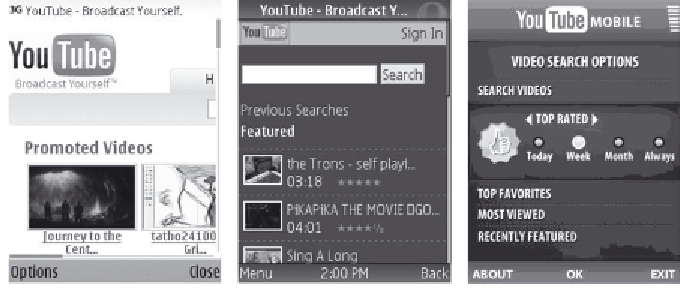Information Technology Reference
In-Depth Information
Figure 3. Left: Mobile access to YouTube web service, Middle: mobile version of YouTube service and
Right: The same service as an experimental Internet-connected application (Zuverink, 2008. Used with
permission).
phones and full screen phones (iPhone). The
smaller the screen, the fewer features, and a more
scaled-back design is needed. Nielsen proposes
as the very best option to go beyond browsing
and offer a specialized downloadable mobile ap-
plication for the most devoted users. In practice,
however, he admits that only the biggest and rich-
est sites can afford all this extra work on top of
their desktop-optimized website.
network sparingly, helping and guiding user input
as well as giving consideration to users on the
go (Daoust & Hazaël-Massieux, 2008). Hinman
et al. (2008) suggest designing mobile services
for “skimming the surface”. They point out that
valuable mobile experiences are not immersive
but mobile services have to be designed with in-
terruptions in mind. Trust becomes increasingly
important as mobile services get more and more
embedded in people's personal lives (Kaasinen,
2009). The most important issue, however, is to
provide value to the mobile user. The following
subsections highlight some promising service
possibilities based on mobile values.
Recommendations for
Future Services
Mobile Web Best Practices by W3C (2008a)
defines key guidelines to follow to provide an
appropriate user experience on mobile devices.
Mobile Web Application Best Practices by W3C
(2009) extend the guidance to taking advantage
of the capabilities of each device. These two
guidelines provide practical guidance with which
to design mobile Internet services, taking into
account the restrictions of mobile devices and
the fact that user goals for mobile use are dif-
ferent than those for desktop browsing (Daoust
& Hazaël-Massieux, 2008). Key issues include
relying on standards, taking into account device
limitations, optimizing navigation, checking
graphics and colors, keeping it small, using the
From Mostly to Always Online
The change from mostly online to always online
may be the biggest effect of the mobile Internet.
Having a portable device that is continuously con-
nected to the Internet enables continuous activi-
ties that may even span across different devices.
This means that users may for instance start an
activity such as reading e-mails or news feeds on
their mobile phones on the way from work to then
continue reading and answering them on their TV
or desktop. In this way the mobile service extends
the usage of the original service.

Search WWH ::

Custom Search